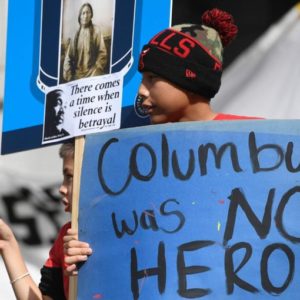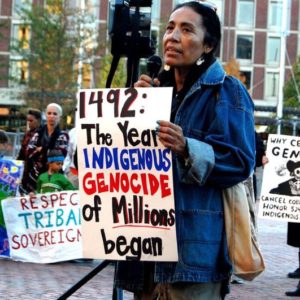According to CNN, Vermont is the most recent state to change the tile of Columbus Day to Indigenous People Day. Columbus Day is a holiday that is usually celebrated the second Monday of every month. However, many states have decided to swap the name of the holiday named after the famous explorer to a title that commemorates the Indigenous People. In fact, according to CNN, South Dakota has celebrated Native Americans Day in place of Columbus Day since 1990. According to pewresearch.org, “Columbus Day is one of the most inconsistently celebrated U.S. holidays. It’s one of the 10 official federal holidays, which means federal workers get the day off.” Therefore, banks and other federal offices celebrate this holiday, nationally; other than that, pewreserach.org reports that only 23 states celebrate Columbus Day as holiday.
Also, CNN reports that there are more than 11 places in this past 12 months that changed the name of the holiday, including Phoenix, Ariz., Lincoln, Nebr., Santé Fe, N.M., Eugene, Ore., and Denver, Colo.
Many people may be against the celebration of Christopher Columbus because he did not discover a New World; in fact, there were indigenous people residing on the Western Hemisphere when he explored, with his first trip being in 1492.
“For One, Columbus, when we look at Columbus Day, is someone who was supposed to have discovered America, in reality. [Be]cause you already had a population who was here for a century prior Columbus, so while he was here in the 14th century he certainly was not the first person. And so if we want to state that a person discovered something, it’s kind of difficult to go along with that if we recognized fully…that the population of indigenous people here … for thousands of years. Depending on what area you want to use looking at ten to thirty thousand years ago, we had Native Americans populations here. So it is more than inaccurate to … say that Columbus discovered America,” said Dr. Susan Papas, an adjunct professor who specializes in Anthropology.
In fact, for thousands of years the Native Americans were discriminated against for an extended period of time in America, beginning with the exploitation from other countries, such as Spain and France and England.
“So it depends on how accurate one wants to be, but at the same time, you also have to also consider the fact that we’re looking at population of indigenous peoples in this country that were basically ignored. And people have not historically really looked at them as not being a part of our society, depending on what time span you are looking at,” said Dr. Papas. “So we’ve gone through periods of time in the United States … in the very beginning, working with them but very rapidly moving to let’s take their land and what they have; and it really depended on which country that really came here and what they want from this culture, what they wanted from North America…For instance, the Spanish, they just wanted to convert the population and take whatever gold they had. The French and the Russians wanted to basically use them for trade. And the English wanted their land; they just wanted to colonize… These were people that they didn’t value.”
Historically, Native Americans were discriminated against. They were forced to move from their lands, they were massacred countless times, and, even more, their ideas and culture were stolen; and they were not given recognition for their accomplishments.
“US Confederacy took the portions of different constitutions and other aspects of it from the Iroquois confederacy because they had this [system of]checks and balances within their government,” said Dr. Papas. “So we have learned so much from the Native American Population but we don’t recognize so much of it, unfortunately.”
Native American discrimination is still occurring today with the most recent example involving the Dakota Access Pipeline. In 2016, Native Americans protested the construction of pipelines that would desecrate Sacred Native American Lands. The construction of the pipeline which would run across these sacred lines illustrates how the Native American population is frequently pushed aside. However, due to the large gathering of numerous tribes to protest, the construction of the pipeline was halted, suggesting that large population of Native Americans enacted change. In fact, in states and cities where the Native American populations, such as in South Dakota, are larger they voice can be heard and their issues are more likely to be addressed. This is evident through the decision of the government ruling that Columbus Day is celebrated as Indigenous Peoples Day in many places over the country. However, there is still a lack of representation of Native Americans because there is not a concentration of this population everywhere in the country.
“It is the same kind of thing, the fact that so many places don’t recognize Native Americans and you’re looking at South Dakota in comparison to other parts of the country; for one, you have more tribes represented there, in a sense, that people visually see Native American population. You look at some portions of the country people [don’t] realize they exist any longer,” said Dr. Papas.
Most people in the United States does not know how large the population of Native Americans is because “it depends [on]what part of the country you are in,” according to Dr. Papas. For example, in Florida, the Seminoles is a tribal group that contains a large population of Native Americans. However, there are “many parts of the east coast and west coast” that are not exposed to a large population of Native Americans, said Dr. Papas. In fact, some tribes have been wiped out, almost to extinction, according to Dr. Papas. The lack of exposure may be a reason for people being unaware of the Native American’s existence or contribution to the American society.
“One of things I do with my Native American classes is ask in a short survey at the very beginning of the class, ‘do Native American population even exist still today?’ And it is amazing of how many people will actually say either ‘they don’t know’ or ‘no, [they]don’t exist,’” said Dr. Papas.
This lack of exposure may also be a reason for the constant discrimination of Native Americans. Dr. Papas explained that due to the small percentage of Native American people in the country many people may wonder “Why they should consider them?” Therefore, the lack of exposure allows people to push Native Americans aside, allowing for discrimination as mentioned before. In fact, “Oklahoma City, home to one of the nation’s largest Native American populations, city leaders rejected a proposal for the second year in a row to celebrate Indigenous Peoples Day,” according to CNN. Some people may wonder if states or cities denying Native Americans the right to have the name of day changed is yet another form of discrimination.
“In a sense it is [discrimination]because you’re not recognizing who they are to start with and their value as a part of a population. Even if you don’t want to change the day itself to Indigenous Peoples, to not allow them to at least have it for themselves makes it even worse, and because you’re basically not
recognizing who these people were and that there culture did exist here … but also not to recognizing what these people were prior to conquest [and]the level of civilization that existed here prior to conquest.”
Many Americans are unaware of the Native Americans’ beliefs and their contributions to American society due to lack of knowledge or education on the subject of Indigenous People. The Native American culture and their contributions is overshadowed by Columbus, who was said to “discover” the New World.
“You’re looking at, for one, a lot of people don’t recognize what their history is. And so many people don’t realize what Columbus did when he got here. And [they]don’t know the history of the Native American and who they were what they were and what they lost and so forth. They don’t see the value of the culture. So if they don’t see the value of the culture and who these people were and are today and why would they be willing to change. I think once there is an increasing amount of education in terms of who the Native population is,” said Dr. Papas. “Of course I think that is one of our jobs is to educate these students so they have a real recognition of the value who these people are.”
Depending on the Native American population and the knowledge of their population in each area, for Dr. Papas, it will be interesting to see if change will happen and if each state will decide to celebrate Indigenous Peoples Day. Only time will tell if states and cities that celebrate Columbus Day will celebrate Indigenous Peoples Day instead, and if states that don’t celebrate Columbus Day will celebrate Indigenous Peoples Day.






